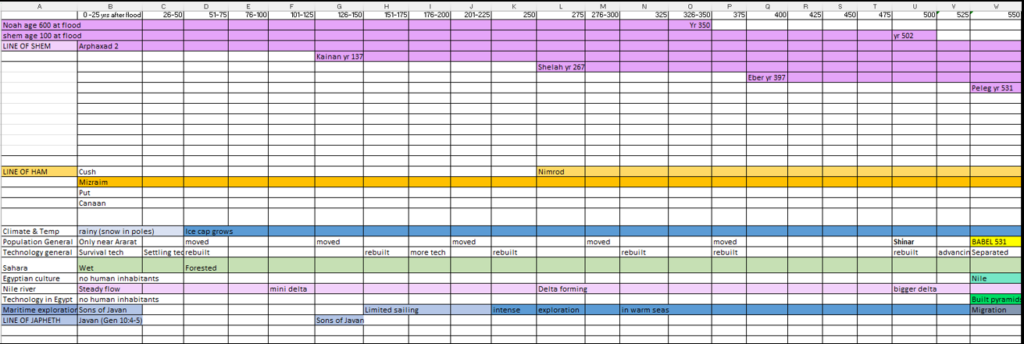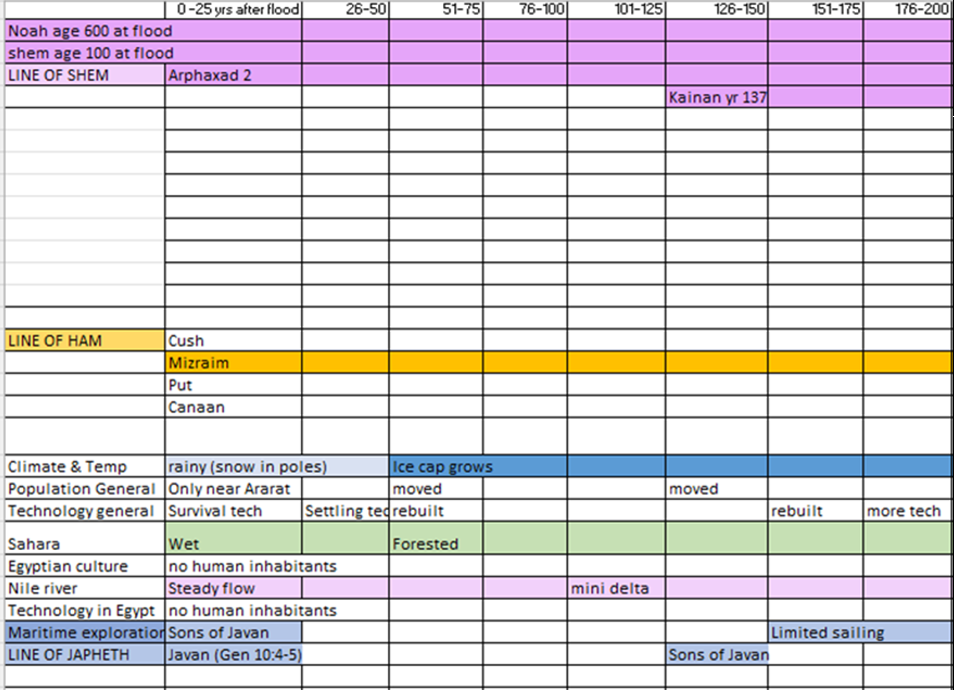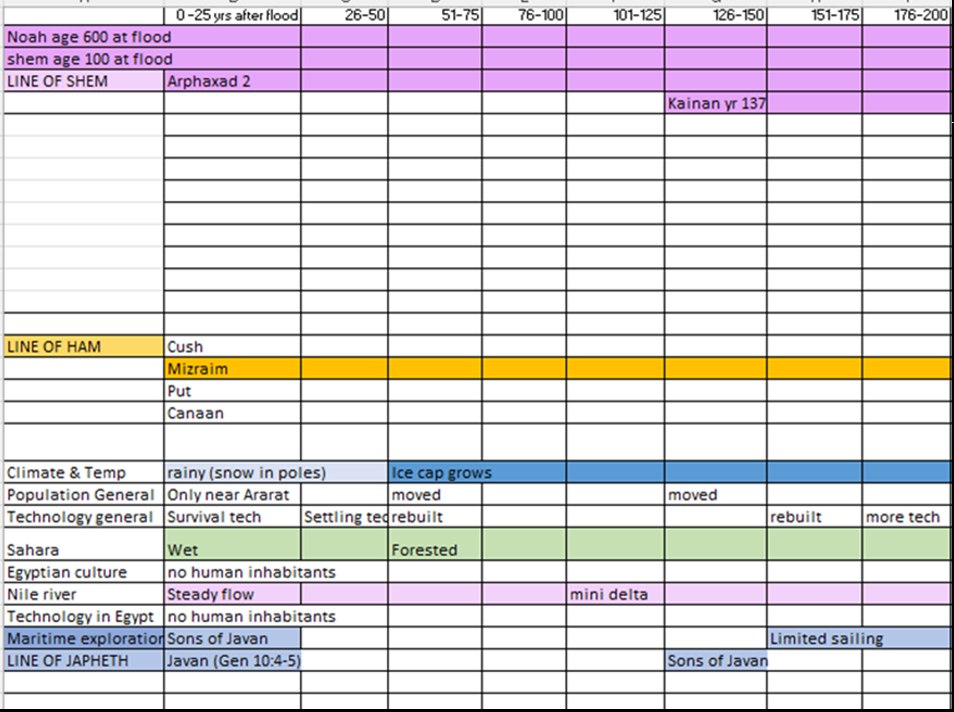Troublesome Topic: ADVANCED TECH FROM THE FLOOD TILL BABEL
Lesson 4 of 10THE WORLD-WIDE FLOOD
Consider this – Only 8 righteous people in the whole world! Some Christian scholars have made calculations and come up with a low estimate for the population of the pre-flood world of 750 million people, and a high estimate of 4 Billion! It is amazing to consider, even if we say 2 billion people and only 8 righteous ones. We think we have it bad now as our culture gets darker. Words cannot describe what Noah likely went through.
We don’t know how advanced they were, we only have a few hints.
Besides the use of Iron long before secular scholars think was possible, we know that Noah, who is called “a man of the soil” (Gen 9:20) was able to build a huge ship that could weather the worst storm ever. And we know that shortly after the flood, lots of them could do amazing things; this hints that such knowledge came from before the flood.
We only have a general statement of how wicked they were. But we have a detailed account of God’s punishment on the entire world, an act that is evidenced in innumerable ways in the rocks beneath our feet. Since God has revealed His character to us, we know that He never over-punishes. The level of His punishment is always merited by the level of the sin. Therefore, the description in great detail of the punishment God chose for them should persuade us that they were indescribably wicked.
God did not want us to find any relics of their civilization and say, “Wow, look how advanced they were; I want to be like them.” Rather He wanted us to say, “Look how wicked they were; I don’t want to ever be like them.”
So God buried all their accomplishments under lots and lots of sediment which became sedimentary rock! In many places, the rock laid down by the flood is over 1,000 meters thick, often several thousand meters thick. In some places today we can see examples of part of the layering of that sedimentary rock.
Consider the extent to which God went to cover up all of man’s achievements, if even the innocent animals were destroyed, except for a representative pair from each kind. God really, really wanted no trace of the pre-flood civilizations to survive.
I personally think, that before the flood, they did have some power source that was as useful to them as our electricity is to us, and some form of computing that allowed them to do some of the same things we can do today, maybe more. Only God knows. Did they get into manipulating DNA? We don’t know. Did they create weapons of mass destruction? We don’t know. All we can be sure of is this: Their level of wickedness and godlessness was so great that God considered it necessary to do more than just eliminate the people, He also covered all of their accomplishments with thousands of meters of sedimentary rock!
At the end of the flood, the ark settled on one of these mountains, either Greater Ararat (on the right), or lesser Ararat (on the left); it landed on a “high place.” In fact, the name Ararat, meant “high place.” Landing the ark on a high place gave glory to the Creator and showed that to enter a relationship of intimate fellowship with the Creator God we need to do things God’s way, not man’s way.
Conclusion #1: Before the flood, man was extremely intelligent and seems to have developed an advanced civilization. But they became self-absorbed, self-sufficient, arrogant, godless, uncaring and brutal. Therefore, God punished them severely.
NOAH’S SONS AND GRANDSONS
Like so many before the flood, Noah was very intelligent, and passed on that intelligence to his descendants. We have seen evidence of the intelligence of people shortly after the flood; I believe most of their knowledge came to them through Noah from before the flood. If Noah and his sons were as intelligent as it seems they were, it is no stretch at all to envision them making cranes and other equipment to help them build the ark.
God commanded Noah and his sons to “fill the earth” (Gen 9:1). But immediately after the flood they stayed together because they were so few in number. I doubt we will ever find the ark. It was probably scavenged by Noah and his sons for anything useful. Also, the area called Ararat has long had much volcanic activity, and the volcanic eruptions would have been larger and more frequent at that time. So the ark is probably covered by volcanic ash, or encased in volcanic rock.
This is my timeline of people and events shortly after the flood. Each cell is 25 years.

Gen 10:4&5 tell us that from Japheth’s son, Javan, (bottom rows of my timeline in blue) came the maritime peoples that spread out into their territories after the tower of Babel. I believe that even before the tower of Babel (bright yellow, far right), these grandsons of Japheth were sailing and exploring. Then, when the dispersion was brought about by God at the tower of Babel, they already knew of good places to go and settle.
There is physical evidence of the influence of Mizraim (Egypt) in various parts of the world, including South America and Australia. But I believe from what we read in Genesis, that it was the sons of Javan that did most of that migrating by sea and made it possible for a few others as well. An ice bridge from Russia to America was probably present for a time and it was used by some animals. However, I think the relatively small population at that time (only 500 plus years to repopulate after the flood) generally stayed away from the areas covered in ice. Therefore, it is best to theorize that the migration of people to distant parts of the globe right after Babel happened by various means.
LIFE RIGHT AFTER THE FLOOD
According to research done by Answers in Genesis, during the first 800 years after the flood, conditions would have been ripe for extreme weather conditions.
One of them was hyper canes (hurricanes the size of continents that lasted for months).
They also had lots of huge volcanic eruptions. Right after the flood the people had to move a number of times to get away from the volcanic activity prevalent in the region of Ararat which is in modern-day Turkey. So they moved to what they thought was a safe place, started to settle down, and then were forced to move again. Based on the timing of the tower of Babel, we can deduce that they repeated this pattern for around 500 years.
AN ICE AGE
There was an ice age. Not multiple ice ages that lasted thousands of years each. Just one.
Evolution presents no good cause for even one ice age and no reason for why it stopped. The Biblical account of the world-wide flood is the perfect cause for an ice age which lasted 700 plus years.
The flood created extremely warm oceans, which created high levels of evaporation followed by lots of rain or snow.

As the snow accumulated in the poles it eventually became heavy enough to compress the lower portions into ice. As the planet slowly cooled, the areas covered in snow and ice began to extend further away from the poles. That is rightly the beginning of the ice age.
The key to the spread of the ice sheets was cool summers. The key to cool summers is lots of volcanic activity that blocks out the sun enough to cause temperatures to be lower and snow to not melt very much. Thus, snow and then ice would accumulate but never go away. There is good evidence that there were ice caps that developed during the ice age on mountain tops in Africa, South of Egypt, such as Mount Kilimanjaro. It still has snow today even though it is in Kenya. During the ice age, there was much more snow and ice than exists today. But that snow has always been on higher elevations, not in the lowlands of Africa. During the Ice age the ice would have extended much further down the mountain.
On my timeline I show the true Ice Age (blue line 2/3 of the way down) lasting from about 50 years after the flood to about 600 years after the flood.

I think the melt-off (grey on the far right) lasted an additional 100 years in cold climates but less in warm climates like Egypt.
During the ice age after the flood, there were heavy and consistent rains that fell on Northern Africa, what is now the Sahara desert.

That is why scientists have found evidence of lush forests under that desert. But, from what I see in God’s word, during most of the time when the Sahara was a forest, that area was uninhabited because all the people were sticking together and moving toward the valley of Shinar. During that period, the Nile had a steady flow all year round and thus the Nile delta began to form. However, something happened later that would cause the delta to grow more rapidly.
Before we can talk about Babel, we need to talk about Nimrod. Even though Nimrod was an important figure, the Bible seems to mock his importance by not giving us the meaning of his name.
Genesis 10:8
Translation
And Cush begat Nimrod; he began
Go to footnote number 1to be a mighty one
Go to footnote number 2on the earth.
Paraphrase
And Cush (origin and meaning unknown) had a son whom he named Nimrod (origin and meaning unknown). Nimrod possessed great size and strength and he set out while he was young to become the most valiant, proud champion alive, as well as a tyrant over all the people in the world at that time.
It appears that, from an early age, Nimrod set out to become a “mighty one.” The word rendered “mighty one” can mean “strong, giant, champion, proud, valiant, tyrant, one who magnifies himself, mighty, or chief.” I believe that Nimrod was the one who kept everyone together in order to build the tower of Babel. I also believe that he possessed the perfect combination of qualities that made him a true Nephilim, even though he is not called by that name in Scripture. I describe him as a political genius, able to present a gentle and friendly side of himself. But he was also a ruthless tyrant, and a strong giant who could force his will on anyone because he was a champion at hand-to-hand combat.
Genesis 10:9
Translation
He was a mighty hunter
Go to footnote number 3before the face of YHVH (read Adonai). Thus, on account of this it is said, “Like Nimrod, a mighty hunter in the face of YHVH (read Adonai).”
Paraphrase
He was so mighty he would slay almost any creature that exists in the presence of THE ETERNAL AND PERSONAL GOD just to show he could do it. That is why the saying developed, “Like Nimrod, the mighty one who can slay any creature in the presence of THE ETERNAL AND PERSONAL GOD.”
The word that is usually translated “hunter” can also mean “chaser, or catcher.” The context of the passage implies that it is referring to something more than your average guy trying to shoot a deer to provide meat for his family. I believe he was called a mighty hunter or catcher because he used his amazing strength and ability to fight and subdue animals that no one else would risk fighting against. Based on some comments in Job 41, I think he was not able to subdue the Leviathan, but it is possible that he vanquished all other land animals (or quasi-land animals). He probably performed these exploits in large arenas to impress and intimidate people. His intimidation worked. Everyone knew that it was not worth it to mess with Nimrod.
Is it possible that Nimrod was a great catcher of people? I believe so.
Besides being very strong, possibly a giant, he also knew how to make a good impression in public. Usually he was able to sweet-talk people into doing what he wanted them to do. He was also able to persuade them that, if they followed his lead, they could all enjoy a prosperous society. However, his sheer size always carried the silent threat that he could use force when he needed to.
But they were not following the command of God to spread out and fill the earth, they were not honoring Him as creator and Lord, rather they worshipped other gods that they had created with their own hands.
The next lesson in this study on Advanced Technology in Ancient times is ADVANCED TECH, BABEL, AND THE DISPERSION
Footnotes
1: "he began"
This is an interesting word that has a root meaning of “pierce” and usually means things like “to wound, profane, pollute, defile, violate,” or in the causative form in which it appears in this verse – “to begin, open, loosen.” This word, or another one that looks just like it, can also mean “pipe, play the pipe.” Here it simply means “begin to or began to.” It is a beginning in the same way that a “wound” is begun by something “piercing” the skin. However, context must indicate if what has been started will have positive or negative consequences. Because of the strong connection to the ideas of “pollute, defile, profane and violate,” the use of this word may often lean toward the negative, although positive uses are found as well. Here the context is slightly negative, and to me it becomes more negative the more I look into what was going on.
2: "mighty one"
This word can mean “strong, giant, champion, proud, valiant, tyrant, one who magnifies himself, mighty, chief.” It appears that Nimrod was singled out because he was a combination of several of these things. I believe that Nimrod was the one who kept everyone together in order to build the tower at Shinar, later called the tower of Babel. I also believe that he possessed the perfect combination of qualities that made him a true Nephilim. I describe him as a political genius, a ruthless tyrant, a talented architect and builder and a strong giant who could force his will on anyone because he was a champion at hand-to-hand combat.
3
This word does mean “hunter, chaser, or catcher.” However, the context of the passage implies that it is referring to something more than your average guy trying to shoot a deer to provide food for his family. That is why I have indicated in my paraphrase that he used his power and ability in this area to impress and intimidate people.